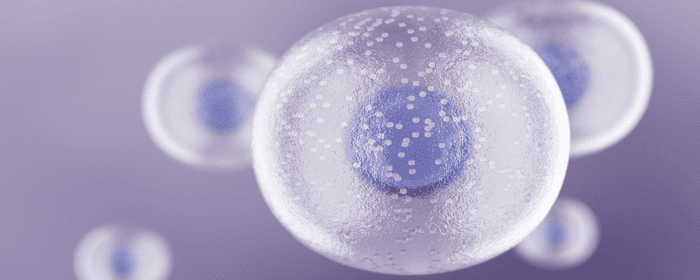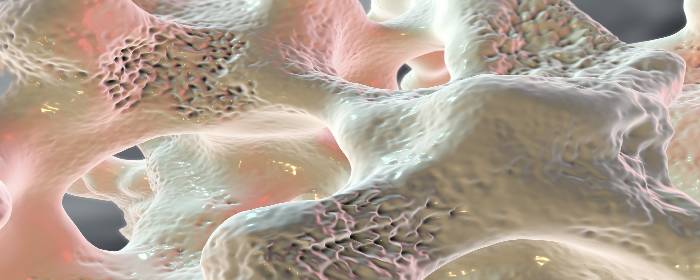
by admin | Mar 1, 2023 | Mesenchymal Stem Cells, Stem Cell Research, Stem Cell Therapy
Osteoporosis is a common bone disease that occurs as a result of the body’s inability to create new bone as fast as the body is losing bone. Characterized by progressively weakened bones and decreased bone density over time, osteoporosis often results in fractures of the wrist, hip, or spine.
Currently, it is estimated that 10 million Americans have osteoporosis and an additional 44 million have low bone density considered significant enough to increase the risk of developing osteoporosis. Recent studies indicate that roughly 50% of women and 25% of men over the age of 50 will break a bone as a result of osteoporosis[1].
While traditional methods of managing osteoporosis include medication, regular participation in weight-bearing exercises, and eating a healthy diet, the condition cannot be cured through these current approaches. Recently, regenerative medicine, also known as stem cell therapy, has drawn attention as a potential new approach to regenerate bone tissue and as a way to treat osteoporosis.
Specific stem cells, known as mesenchymal stem cells (MSCs), are widely considered to be the most promising of all stem cells for regenerative applications – primarily because of their anti-inflammatory, immune-privileged potential and less ethical concerns than other forms of stem cells.
In this review, Arjmand et al. consider all the currently known effects of stem cell-based therapies, including MSC-based therapy, in the treatment of osteoporosis. Several studies have confirmed the relationship between osteoporosis and a clear reduction in endogenous MSCs’ ability to proliferate, differentiate, and ultimately form new bone. Considering this, MSCs have been the most common type of stem cell investigated for the treatment of osteoporosis in both animal models and humans.
The authors point out several advantages of using MSCs in clinical models, including their accessibility and ease of harvesting, immunosuppressive outcomes, and ability to differentiate. Arjmand et al also highlight evidence that indicates MSCs to be effective in this application most likely as a result of their paracrine effects and their supporting regenerative microenvironment ability and not solely a result of their ability to differentiate. Considering these observed paracrine effects, the authors believe MSC transplantation could open a host of new opportunities for the treatment of osteoporosis.
This review concludes by calling for further studies into stem cell therapy as a potential treatment for osteoporosis specifically to understand the outcome and biodistribution of MSCs after transplantation and to further identify important bone loss signaling pathways and genes specific to each individual.
Source: “Prospect of Stem Cell Therapy and Regenerative Medicine in … – NCBI.” 3 Jul. 2020, https://www.ncbi.nlm.nih.gov/pmc/articles/PMC7347755/.
[1] “Learn What Osteoporosis Is and What It’s Caused by.” https://www.bonehealthandosteoporosis.org/patients/what-is-osteoporosis/. Accessed 1 Feb. 2023.

by admin | Nov 7, 2019 | Stem Cell Research, Adipose, Stem Cell Therapy
Osteoporosis is a disease in which bones become weak, brittle, and are prone to fracture. While osteoporosis is commonly considered a disease of low bone density, it is more complex and extensive than that. New bone is constantly formed and destroyed (resorbed) throughout life. In osteoporosis, however, the rate at which it is resorbed accelerates, while the rate at which it is formed slows down. In other words, bone is being destroyed faster than it can be formed. This process changes the size and shape of bones and alters its microarchitecture (i.e. the structure of bone on a microscopic level).
Without screening, most people will not know that they have osteoporosis until they have a bone fracture. Bones simply get weaker until some minor trauma causes one or more bones to break. Fortunately, efforts to screen for the disease (e.g. DXA/DEXA or bone density scans) have helped doctors diagnose cases of osteoporosis before the disease progresses to the point of bone fracture.
The main treatment for osteoporosis is a class of drugs called bisphosphonates. Bisphosphonates block the cells that resorb bone (osteoclasts) to allow the cells that form new bone (osteoblasts) to catch up. While bisphosphonates are effective, many patients experience severe GI side effects from these drugs including reflux, esophagitis, and ulcers, and cannot take them.
In an effort to find new ways to treat osteoporosis and help patients who cannot tolerate bisphosphonates, researchers are exploring the possibility of using stem cells to treat the disease. Ideally, one would take stem cells from patients to help regrow bone. What has been unclear was whether a person with osteoporosis still has enough healthy stem cells to effectively regrow bone.
To test this, Dr. Jiang and colleagues collected stem cells from the fat tissue of patients with osteoporosis (i.e. adipose-derived stem cells). The researchers took these stem cells and encouraged them to grow and multiply for 14 days. After the stem cells had proliferated, they injected the cells into mice and studied the effects on bone growth. After 4 weeks, the researchers saw evidence on X-ray scans that adipose-derived stem cells caused new bone growth.
These results demonstrate that even patients with osteoporosis still possess stem cells that can be used to treat their own osteoporosis. While the stem cells need to be treated in a laboratory setting for 14 days, it is potentially possible to use a patient’s own stem cells to regrow bone and treat their osteoporosis.
The next phase of research will be to conduct a clinical trial to show test whether autologous stem cell treatment (injecting a patient with their own stem cells) can regrow bone in humans. While those clinical studies will be critical in determining whether this approach is practical and effective for patients, this laboratory research is very promising.
Contact us today!
Reference: Jiang M. et al. (2014). Bone formation in adipose-derived stem cells isolated from elderly patients with osteoporosis: a preliminary study. Cell Biology International. 2014 Jan;38(1):97-105.

by admin | Oct 25, 2019 | Adipose, Osteoarthritis, Stem Cell Research, Stem Cell Therapy
Osteoporosis is a disease in which bones become weak, brittle, and are prone to fracture. While osteoporosis is commonly considered a disease of low bone density, it is actually more complex and extensive than that. New bone is constantly formed and destroyed (resorbed) throughout life. In osteoporosis, however, the rate at which it is resorbed accelerates, while the rate at which it is formed slows down. In other words, bone is being destroyed faster than it can be formed. This process changes the size and shape of bones and alters its microarchitecture (i.e. the structure of bone on a microscopic level).
Without screening, most people will not know that they have osteoporosis until they have a bone fracture. Bones simply get weaker until some minor trauma causes one or more bones to break. Fortunately, efforts to screen for the disease (e.g. DXA/DEXA or bone density scans) have helped doctors diagnose cases of osteoporosis before the disease progresses to the point of bone fracture.
The main treatment for osteoporosis is a class of drugs called bisphosphonates. Bisphosphonates block the cells that resorb bone (osteoclasts) to allow the cells that form new bone (osteoblasts) to catch up. While bisphosphonates are effective, many patients experience severe GI side effects from these drugs including reflux, esophagitis, and ulcers, and cannot take them.
In an effort to find new ways to treat osteoporosis and help patients who cannot tolerate bisphosphonates, researchers are exploring the possibility of using stem cells to treat the disease. Ideally, one would take stem cells from patients, purify them, get the cells to multiply in the lab, and inject them back into patients with osteoporosis to help regrow bone. What has been unclear was whether a person with osteoporosis still has enough healthy stem cells to effectively regrow bone.
To test this, Dr. Jiang and colleagues collected stem cells from fat tissue of patients with osteoporosis (i.e. adipose-derived stem cells). The researchers took these stem cells and encouraged them to grow and multiply for 14 days. After the stem cells had proliferated, they injected the cells into mice and studied the effects on bone growth. After 4 weeks, the researchers saw evidence on X-ray scans that adipose-derived stem cells caused new bone growth.
These results demonstrate that even patients with osteoporosis still possess stem cells that can be used to treat their own osteoporosis. While the stem cells need to be treated in a laboratory setting for 14 days, it is potentially possible to use a patient’s own stem cells to regrow bone and treat their osteoporosis.
The next phase of research will be to conduct a clinical trial to show test whether autologous stem cell treatment (injecting a patient with their own stem cells) can regrow bone in humans. While those clinical studies will be critical in determining whether this approach is practical and effective for patients, this laboratory research is very promising.
Reference: Jiang, M. et al. (2014). Bone formation in adipose-derived stem cells isolated from elderly patients with osteoporosis: a preliminary study. Cell Biology International. 2014 Jan;38(1):97-105.




 St. Petersburg, Florida
St. Petersburg, Florida
